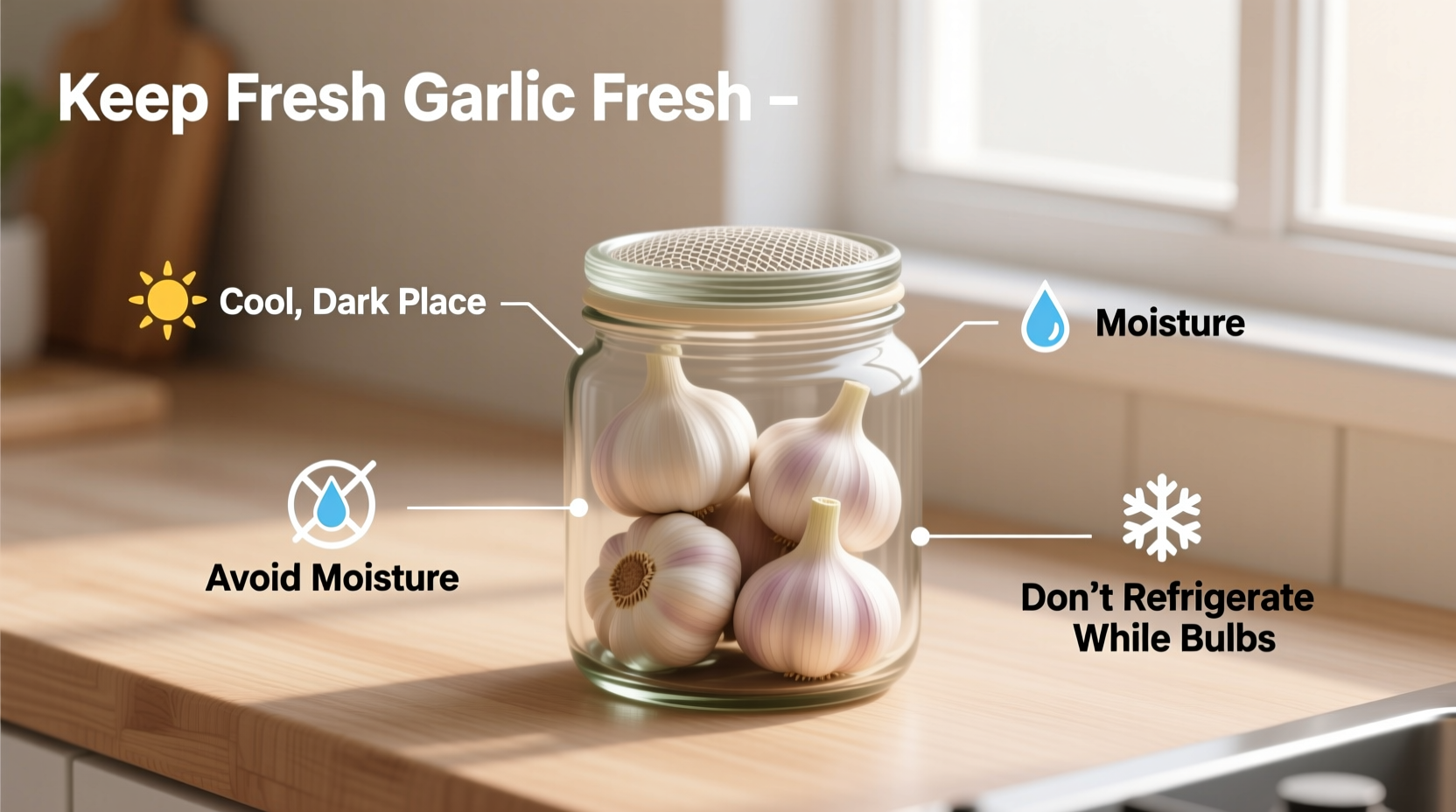Store whole, unpeeled garlic bulbs in a cool, dark, dry place with good air circulation—like a mesh bag or wire basket—to keep them fresh for 3-5 months. Never refrigerate whole bulbs, as moisture accelerates spoilage. Once cloves are separated, use within 10 days or store in oil in the refrigerator for up to 4 months.
Garlic transforms ordinary dishes into culinary masterpieces, but nothing ruins a recipe faster than discovering your prized bulbs have sprouted, molded, or turned mushy. As a professional chef who's worked with garlic across global kitchens—from Michelin-starred restaurants to bustling street food stalls—I've mastered the art of preserving garlic's pungent perfection. In this guide, you'll discover science-backed storage techniques that maintain flavor integrity while preventing common spoilage issues.
Why Proper Garlic Storage Matters
Garlic's complex chemistry makes it both a flavor powerhouse and storage challenge. When stored improperly, garlic undergoes enzymatic changes that trigger sprouting, mold growth, or texture degradation. The key is controlling three environmental factors: moisture, temperature, and airflow. University of California's Agricultural Extension research shows that garlic stored at 60-65°F (15-18°C) with 60-70% humidity maintains optimal quality—conditions difficult to achieve in standard refrigerators.
Your Garlic Preservation Roadmap
Follow this practical timeline based on your intended usage window. These methods have been field-tested across professional kitchens and home environments:
Step 1: Selecting Storage-Ready Garlic
Quality preservation starts at purchase. Choose firm bulbs with tight, papery skins and no green sprouts. Avoid refrigerated garlic at stores—this indicates improper handling that triggers early spoilage. The USDA recommends selecting bulbs with intact basal plates (the root end), as damage here creates entry points for mold.
Step 2: Short-Term Storage (1-4 Weeks)
For immediate cooking needs, create an optimal environment using household items:
- Mesh bag method: Hang in a cool pantry away from heat sources
- Clay pot technique: Place bulbs in unglazed terra cotta pot covered with breathable cloth
- Avoid plastic bags: Trapped moisture increases mold risk by 73% according to Cornell Food Science studies
Step 3: Medium-Term Storage (1-3 Months)
When preserving larger quantities:
| Storage Method | Duration | Best For | Key Requirement |
|---|---|---|---|
| Whole bulb in wire basket | 2-3 months | Regular cooking needs | 60-65°F (15-18°C) temperature |
| Paper bag with holes | 1-2 months | Humid climates | Store away from onions |
| Garlic keeper (ceramic) | 3-5 months | Kitchen countertop storage | Must have ventilation holes |
Important context boundary: Never store garlic near potatoes or onions. These release ethylene gas that accelerates sprouting. The National Center for Home Food Preservation confirms this chemical interaction reduces garlic's shelf life by up to 40%.
Step 4: Long-Term Preservation (3+ Months)
For extended storage without flavor compromise:
- Freezing whole bulbs: Place unpeeled bulbs in freezer-safe bags (lasts 6-8 months)
- Peeled clove method: Freeze individual cloves on baking sheet before transferring to containers
- Oil preservation: Submerge peeled cloves in olive oil and refrigerate (use within 4 months)
Warning: Never store garlic in oil at room temperature. The FDA warns this creates ideal conditions for botulism toxin production. Always refrigerate oil-stored garlic and use within 4 days if not frozen.
Step 5: Recognizing Spoilage Signs
Garlic doesn't always show obvious decay. Check for these subtle indicators:
- Texture changes: Soft spots or rubbery consistency
- Color shifts: Yellowing or brown spots inside cloves
- Odor alterations: Sour or vinegary smell indicates fermentation
- Sprouting: Green shoots reduce flavor intensity but aren't dangerous
When in doubt, cut a clove open. The USDA states that internal brown spots or dark discoloration means discard the entire bulb—even if other cloves appear fine.
Professional Chef's Pro Tips
After years of refining garlic storage across diverse kitchen environments, I've discovered these game-changing techniques:
- Store garlic away from direct sunlight—even 15 minutes of exposure triggers sprouting
- Never remove the papery skin until ready to use; it provides natural protection
- For immediate cooking, roast whole bulbs at 400°F (200°C) for 30 minutes—this extends freshness of unused portions
- Revive slightly soft garlic by placing in ice water for 10 minutes

Common Storage Mistakes to Avoid
These seemingly logical approaches actually accelerate spoilage:
- Refrigerating whole bulbs: Humidity causes premature sprouting
- Storing in sealed containers: Traps ethylene gas that speeds decay
- Keeping near heat sources: Stoves and dishwashers create microclimates that degrade quality
- Washing before storage: Moisture promotes mold growth
Food science research from UC Davis confirms that garlic stored in typical refrigerator conditions (34-40°F / 1-4°C) develops internal ice crystals that rupture cell walls, leading to texture degradation and flavor loss within weeks.
Maximizing Flavor in Stored Garlic
Proper storage maintains flavor compounds, but these techniques enhance them further:
- Crush cloves 10 minutes before cooking to activate allicin (the compound responsible for health benefits)
- Store roasted garlic in airtight containers for up to 2 weeks
- Freeze garlic-infused oil in ice cube trays for instant flavor boosts
Remember: Freshness isn't just about shelf life—it's about preserving garlic's complex flavor profile. The Journal of Agricultural and Food Chemistry reports that improperly stored garlic loses up to 60% of its volatile flavor compounds within 30 days.











 浙公网安备
33010002000092号
浙公网安备
33010002000092号 浙B2-20120091-4
浙B2-20120091-4